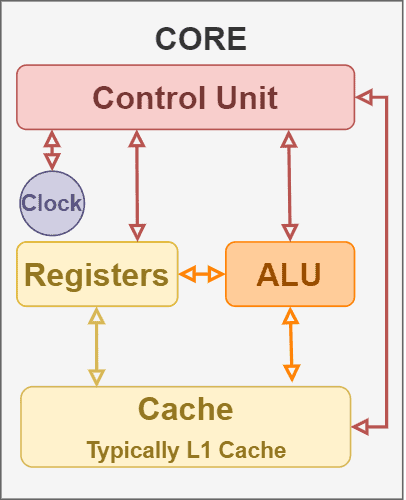1. 引言
假设你要组织一场大型派对,需要完成一系列任务:布置场地、协调供应商、处理宾客名单等。这些工作量庞大,一个人很难高效完成。于是你决定找几个人分工协作,但仍然需要一个“总负责人”来统筹安排和分配任务。
这个场景很像现代计算机中的 CPU 与核心 的协作机制。CPU 就是那个总负责人,它负责调度任务并分发给各个核心(Core),而核心就像派对中的工作人员,负责具体执行任务。
所以,CPU 和 Core 并不是同一个概念。
本文将从技术角度解析 CPU 与核心的区别与联系。我们会从处理器的历史背景讲起,然后分别介绍核心与 CPU 的结构和功能,最后进行对比总结。
2. 处理器的历史背景
20 世纪 70 年代以前,计算机系统中的处理器设计较为原始。由于当时集成电路技术的限制,一个完整的 CPU 通常由多个芯片组合而成,多个部件需要协同工作才能完成一次任务。
到了 70 年代,随着 大规模集成电路(LSI) 的发展,出现了将控制逻辑与数据处理集成在单一芯片上的微处理器。这意味着一个 CPU 可以包含数万个晶体管和上万个逻辑门电路。
随后几十年,集成度不断提高,到了 2000 年初,多核处理器开始普及。一个 CPU 可以集成多个核心,从而实现并行计算。再后来,多线程技术(如超线程)进一步提升了 CPU 的并发处理能力。
3. 核心(Core)
核心是 CPU 中的执行单元,负责执行程序和处理任务。
一个核心通常由以下三个主要部分组成:
✅ 控制单元(Control Unit, CU)
负责与系统其他部件通信,接收指令、发送信号、管理数据流动。它协调 ALU 和内存之间的交互。
✅ 算术逻辑单元(Arithmetic-Logic Unit, ALU)
负责执行基本的算术运算(加、减、乘、除)和逻辑判断(等于、大于、小于)。
✅ 内存单元
包括寄存器(Registers)和缓存(Cache)。寄存器用于临时存储地址、指令和计算结果;缓存则用于快速访问常用数据。
此外,核心还包含时钟和总线等重要组件。下面是一张抽象的核心结构图:

4. 中央处理器(CPU)
CPU 是负责协调多个核心并执行任务的组件。
换句话说,CPU 是整个计算机系统的“大脑”,它不仅管理核心,还负责与其他硬件(如内存、I/O 设备)通信。
一个 CPU 可以同时执行的任务数取决于它所拥有的核心数量。如果支持多线程(如每个核心两个线程),则任务数等于线程总数。
除了核心,CPU 还通常包括:
✅ 内存控制器
✅ I/O 控制器
✅ 二级或三级共享缓存
✅ 集成 GPU(部分型号)
现代 CPU 的设计已经高度集成,很多原本依赖主板芯片组的功能现在都集成在 CPU 内部。
下面是一张抽象的 CPU 结构图:

5. 总结对比
| 项目 | CPU | Core |
|---|---|---|
| 含义 | 计算机系统的处理组件 | CPU 内的处理单元 |
| 数量 | 一个(单处理器)或多个(多处理器) | 一个(单核)或多核 |
| 主要组成 | 控制器、缓存、核心 | 控制单元、算术逻辑单元、内存(寄存器 + 缓存) |
6. 结论
CPU 和核心虽然都参与任务处理,但它们的角色截然不同:
- 核心 是执行任务的单元,负责具体计算。
- CPU 是管理核心的组件,负责任务调度、协调与外部通信。
可以说,核心是 CPU 的“手脚”,而 CPU 是核心的“大脑”。它们相辅相成,缺一不可。
所以,当你看到“4 核 8 线程 CPU”时,就知道它包含 4 个物理核心,每个核心可以运行两个线程,总共能并发执行 8 个任务。这种设计极大提升了现代计算机的性能与效率。